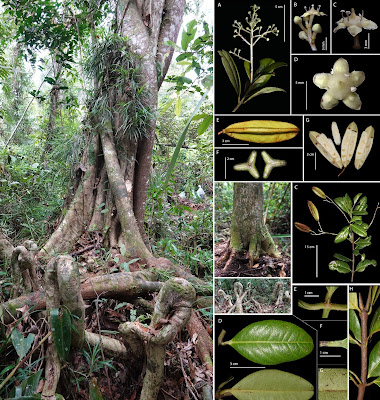 |
| Lophopetalum tanahgambut Randi, Utteridge & Wijedasa, in Randi, Wijedasa & Utteridge, 2022. |
Abstract
A new large tree species from peat swamp forest of Sumatera, Indonesia is described here with new notes on vegetative characters for the genus. Colour plates, as well as distribution, habitat, phenology, uses and observation notes are provided.
Keywords: Celastraceae, Lophopetalae, Lophopetalum tanahgambut, flora of Sumatera, rawa gambut, peatswamp, Eudicots
 |
| Distribution map of Lophopetalum tanahgambut Randi, Utteridge & Wijedasa (red dot). |
Lophopetalum tanahgambut Randi, Utteridge & Wijedasa, sp. nov.
Type:—INDONESIA. Sumatera Selatan Province: Musi Banyuasin Regency, Bayung Lencir District, Muara Medak Village, conservation area of PT Tri Pupajaya forest production concession, 10 m. elev., 1°45’30.66”S, 104°12’19.13”E, 17 April 2021, Randi GB-129 (holotype: BO!; isotypes: WAN!, FIPIA!, SING!).
Diagnosis:—This species is the only known Lophopetalum with 3–4 leaves in a pseudoverticillate arrangement, leaf apex retuse to emarginate, petiole with a pair of ridges to conspicuously winged, panicles solitary in terminal leaf, calyx lobes much wider than long, disk convex, 5-angular with rounded corners, slightly thickened at lobe edges where the stamens are inserted.
Etymology:—The specific epithet ‘tanah gambut’ is formed from the Bahasa Indonesian words for peat soil or peat swamp habitat where this species is found.
Vernacular name:—Kerupuk, Perupok (Palembang Malay); this vernacular name is also used for all species of the genus Lophopetalum, as well as several Kokoona species.
Agusti Randi, Lahiru S. Wijedasa and Timothy M.A. Utteridge. 2022. Lophopetalum tanahgambut, A New Endemic Giant Tree Species from Peat Swamp Forest of Sumatera, Indonesia, with the First Pseudoverticillate Leaf Arrangement in Genus Lophopetalum (Celastraceae). Phytotaxa. 573(1); 115-122. DOI: 10.11646/phytotaxa.573.1.7


